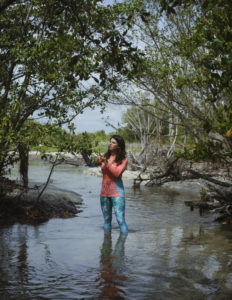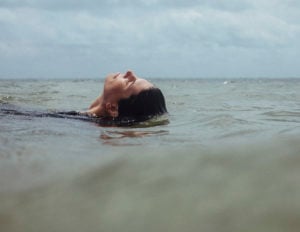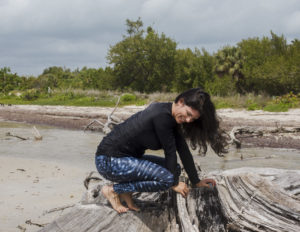Miami Voice | Rachel Silverstein, Miami Waterkeeper
By: Ellen Simon
Rachel Silverstein dives deep to salvage her city’s future.

By Ellen Simon.
Photos by ©Rose Marie Cromwell, courtesy of Culture Trip.
On her fourth day as Miami Waterkeeper, Rachel Silverstein was at her kitchen table, sipping coffee and reading up on nonprofit management, when a New York Times reporter called asking if she knew anything about a coastal coral die-off caused by dredging at the Port of Miami.
That call was the first time Rachel heard that the dredging had failed to protect endangered staghorn corals nearby, as required by the permit. It would lead her to take countless dives in teeth-rattling conditions, spend a year untangling a hidden dataset, and see an Army Corps staff biologist plead guilty to lying to federal investigators. And it would eventually prompt Miami Waterkeeper to file an Endangered Species Act suit against the Army Corps of Engineers.
In the process, Rachel, 35, learned more about managing a nonprofit than any book could ever teach. She put together scrappy teams to fight alongside her. She grew Miami Waterkeeper’s staff from one — her — to six. Its operations moved from her kitchen table to an office in Coral Gables. She also established its reputation as one of the most credible environmental organizations in the region.
“We’re extremely careful that everything we say is backed up by a document or scientific evidence,” Rachel says. “When we call agencies or the community or the media and say something’s a problem, it’s given a lot of weight.”
As a result, Miami Waterkeeper has become the voice for the underwater coral forest offshore from the glittering city and a first-line defender of the natural world, fervently working in an utterly unnatural environment.
“Florida had to be drained and straightened and controlled to allow for development,” Rachel says. “All the channels and canals and retention ponds you see everywhere — those are the remnants of the Everglades.”
But the days of controlling Miami’s environment may be running out. The ocean is rising so quickly that at high tide, seawater ascends through the sewers. Rachel calls her day-to-day work “the tyranny of the urgent.”
Are there days when the work is overwhelming? “Almost every day,” she says.
“One of the hardest things we have to deal with,” she adds, “is saying ‘no’ to working on issues that are in our mission area, that are really important, that we know we could have an impact on – just because of limited capacity.”
ANIMAL, VEGETABLE, AND MINERAL
Growing up in San Diego, Rachel always felt the pull of the ocean. She was the only child in her second-grade class who finished a tide pool field trip soaked to the neck. She learned to scuba dive when she was 14. As a college student, she cobbled together grants from funders, including the Garden Club of America, to study reefs off the western coast of Australia, tracking a DNA marker correlated with reefs’ resilience to climate change. Her undergraduate advisor agreed to send one of his graduate students along. It was the start of an enduring friendship.
The pair’s adventures included a stay on Rottnest Island, off the coast of Perth, where they were given keys to a research truck, the island’s only vehicle, and a quick course on stick-shift driving on the left-hand side of the road. Their only companions were the island’s quokkas, sharp-clawed, cat-sized, decidedly rat-like marsupials. Following an old guidebook from a dusty library, they dove off remote beaches, determined to collect enough corals to justify the trip. They eventually published their research; now, more than 10 years later, her friend’s seven-year-old demands nightly bedtime stories of the trip.
After graduating from Columbia University in 2006 with a bachelor’s degree in environmental biology, Rachel earned a Ph.D. in marine biology from the University of Miami, focusing on the effects of climate change on corals.
Studying corals, she says, is “like studying the trees in the rainforest.” Corals are the underpinning of the whole ecosystem, the place where fish and other marine animals find food, shelter, and a place to reproduce.

“But a lot of people overlook them,” she says. “I like that you really have to pay attention to know that they’re there, and that they’re not rocks. We refer to them as monsters because they’re animal, vegetable, mineral — all in one creature.”
If Rachel had a superpower, it would be her doggedness. Her Ph.D. advisor, Andrew Baker, once compared the number of emails he’d gotten from all his graduate students over six years to the number he’d gotten from Rachel alone. They tallied up to about the same number.
While she was at the University of Miami, Rachel — who had interned at San Diego Coastkeeper as an undergraduate — became friends with Alexis Segal, who was the Miami Waterkeeper. Their trails would overlap again in Washington in 2014. Alexis had left Miami Waterkeeper to accept a fellowship at the White House. Rachel’s first job after graduate school was a Sea Grant Knauss Fellowship with the U.S. Senate Commerce Committee. When Rachel expressed her interest in the open Miami post, Alexis connected her with the group’s board members, and Rachel soon was appointed Miami Waterkeeper.
THE KILLING OF CORALS
When Rachel got that call at her kitchen table, her immediate thought was that a responsible person from the Army Corps of Engineers would meet her for coffee, hear her out, and halt the project after learning about the damage the dredging was doing. But she was quickly disabused of this notion. On her first call to the Corps, she asked Corps biologist Tracey Jordan Sellers for data. Sellers told her to file a Freedom of Information Act Request. The documents didn’t arrive until nine months later. Rachel knew when she hung up that this wasn’t going to be settled over coffee, and reached out to Miami Waterkeeper’s stalwart outside counsel, Jim Porter, who also would serve as dive boat captain on outings to the corals.
“Studying corals, she says, is ‘like studying the trees in the rainforest.’ Corals are the underpinning of the whole ecosystem, the place where fish and other marine animals find food, shelter, and a place to reproduce. But a lot of people overlook them. I like that you really have to pay attention to know that they’re there, and that they’re not rocks. We refer to them as monsters because they’re animal, vegetable, mineral — all in one creature.”
He would help Miami Waterkeeper build an outside legal team, made up of lawyer-outdoorsmen who kick off every call talking about the fish they caught over the weekend. With partner organizations, Miami Waterkeeper filed suit against the Army Corps in October 2014 on the grounds that the staghorn corals killed by the dredging — the same corals Rachel had studied for her Ph.D. — were protected by the Endangered Species Act.
As the litigation played out, Rachel could see the dredging from her kitchen table. There were days she’d call the Army Corps and be told, “The dredging boat might not even be working today.” She’d look out the window and say, “Yes it is.”
She started diving while the dredging was going on. “The current was very strong, and it was hard to see because of all of the sediment in the water” she remembers. “It sounded like something was eating a car next to you. I could feel the vibrations in my chest.”
Four years after Miami Waterkeeper and its partners filed suit, the Army Corps agreed to a settlement that included the restoration of 10,000 staghorn corals in Miami-Dade County over three years, a project carried out by the University of Miami, which had found a way to grow corals in nurseries and replace them on the reef.
It was a win based on a loss. The Army Corps’ contractors had reported that six corals had died because of the dredging, but Rachel knew, from her own dives, that the death toll was much greater. While an individual staghorn coral grows to about seven inches tall, coral grow together, forming colonies. A colony of staghorn coral grows to about four feet high and six feet in diameter. Rachel knew the losses were losses of colonies, not merely a handful of individual corals.
After Miami Waterkeeper and its partners won the settlement, in 2018, Rachel enlisted her academic colleagues to study dredging’s true toll on the corals at the Port of Miami, so that future dredging projects wouldn’t do similar damage.
The Corps’ contractors had kept records of their weekly (and in some cases, twice-weekly) dives monitoring 600 tagged colonies of coral. But rather than using spreadsheets, they had stored each of 1,001 data-points as individual PDFs, making the dataset nearly impossible to analyze. So Ross Cunning, one of Rachel’s former academic colleagues (and lead author of the paper they would eventually publish) wrote a computer program to convert all those PDFs to cells in a spreadsheet, transforming what had been hidden into a dataset a statistician could work with.
The numbers would eventually reveal a story of devastating loss of corals and coral-reef habitat that Rachel, Cunning, Andrew Baker and a fourth colleague, Brian Barnes, of the University of South Florida, would publish in the August 2019 edition of the journal Marine Pollution Bulletin.
“The days when Miami could just take from the ocean are over. As sea levels rise, low-lying Miami is like a child in a bay with her nose just above water at rising tide: The city is going to have to make changes, and make them quickly.”
“We spent most of the last year combing through the contractor’s data and analyzing it, using proper statistics,” Rachel says. “We found more than 560,000 coral had died.”
And that may be an underestimate, Rachel says. After all, the dredging buried an area of reef the size of 200 football fields.
It also became clear that there was a criminal element to the project. Tracey Jordan Sellers, the stonewalling Army Corps biologist who told Rachel to file a Freedom of Information Act Request for basic records, pleaded guilty, in July 2019, to felony charges of lying to federal investigators about working part-time for an outside consultant hired for the dredging.
Unfortunately, the stifling sediment from the dredging isn’t the only threat to the corals. Researchers suspect that the dredging may have also caused an as-yet-unnamed contagious disease that’s killed tens of millions of them — and is spreading. Rachel is working with Baker and Cunning on an epidemiological study of the disease, exploring possible links to the dredging.
There is, however, a ray of hope that Florida’s decision-makers may have learned something from the experience. Miami Waterkeeper and its partners filed another suit, in 2016, warning that the Army Corps would make the same mistakes in a planned dredging project in Florida’s Broward County to the north. The Army Corps essentially conceded, agreeing to redraft all its environmental documents to account for the impacts in Miami. As a result of that suit, dredging in Broward County has been delayed for at least four years.
AT OCEAN’S EDGE
Miami sits on an ancient coral bed. Some of its homes and offices are built from blocks of limestone rich in fossilized coral; you can see the creatures’ skeletons in the walls and sidewalks as you walk the neighborhoods. But the days when Miami could just take from the ocean are over. As sea levels rise, low-lying Miami is like a child in a bay with her nose just above water at rising tide: The city is going to have to make changes, and make them quickly.
It has seen a cumulative sea-level rise of 0.92 feet since 1900, according to a recent article in The Washington Post citing data from Climate Central, a group of scientists and journalists conducting research on climate change. That higher daily level boosts storm surges and high tides. To prepare for ever-rising tides, the city will need to reinforce and elevate its buildings, roads, sewage infrastructure and power infrastructure — including the 49-yearold Turkey Point nuclear-power plant, the only one in the world that uses a system of unlined outdoor canals to cool its water.
“If we want to continue to live in Florida, I don’t think it’s a stretch to say we’ll have to invest tens of billions, just in Miami, just to maintain some sense of functioning 21st-century life,” Rachel says.

Thanks to connections formed as a doctoral student and fellowship recipient, Rachel is on a first-name basis with people in Miami’s government, industry, and law enforcement. But when it comes to winning appropriations for sewer-infrastructure upgrades, she and her staff use a lesson she learned during her Senate fellowship: They show up at the public comment portion of hearings. At a recent county budget hearing, Rachel and her team spoke in favor of a plan to increase funding for Miami-Dade Water and Sewer to fix its pipes. The sewer system’s two main outflow pipes were built in 1956 and 1975. On good days, it pumps up to 143 million gallons of treated sewage into the Gulf Stream. On bad days, segments of its 6,500 miles of pipes corrode and crack, sending raw sewage to local beaches. By law, Miami-Dade Water and Sewer must stop ocean dumping by 2025, but the county is nowhere near ready to meet that deadline.
“Miami-Dade County is currently in the midst — and has been for quite some time — of a sewage-infrastructure crisis,” Rachel stated in September at the county’s final budget hearing of the year. “This body has the power to fix it. Now. To not kick the can down the road, until pipes are literally bursting at our feet.”
Her persistence has paid off. A slim one-vote margin of support for the increased budget going into the meeting turned into a final vote of 10 to 3 in favor — one small step toward fixing the problem.
Rachel knows the levers to pull to win public engagement on an issue like sewer infrastructure. When Miami Waterkeeper got reports in 2017 that a broken sewer line was spewing partially treated sewage into the ocean, she decided that the organization needed underwater video. Unable to dive because she was pregnant, she persuaded Miami Waterkeeper board member Phil Kushlan to dive near the break with an underwater video camera.

“Obviously, I had no interest in going,” Kushlan says. “Rachel explained the treatment level — that it would be gross, but not dangerous. She knows what engages people; she knew we needed video of that outflow pipe, especially video of the sewage literally flowing out. So I made the dive. As soon as they put that out on social media, it really resonated with people, and the county fixed it.”
CONVINCING THE UNWILLING
Much of Rachel’s work comes down to this: nudging people toward change. Along with Miami Waterkeeper’s staff attorney, Kelly Cox, Rachel has thrown herself into the arduous, and decidedly unglamorous, work of convincing cities and towns in the Miami area to pass summer fertilizer bans to protect fragile Biscayne Bay from nitrogen- and phosphorus- pollution. Since summer brings heavy tropical rains to Miami, it’s the time when fertilizer is least likely to be absorbed into the soil, and most likely to be washed away toward Biscayne Bay.
At a late-summer meeting at Coral Gables’ municipal complex, the city’s horticulturist was skeptical. What about the four applications of fertilizer annually, including in summer, for popular non-native palms? How will these transplanted trees, which don’t like the area’s soil, continue to thrive without artificial help?
Rachel used a subtle-charm offensive. Once the horticulturist found out she was a serious orchid buff, as he was, he listened to what she had to say. He checked when she suggested that a quick online search would show the latest research recommended three fertilizer applications a year for the palms, rather than four, with none in summer, and found that she was right.
Rachel and Kelly had spent months pushing for proposed legislation banning summer fertilizer applications, and this meeting did the trick. It’s now on the city’s agenda for a vote.
Score one more win for Rachel over the unwilling.
Andrew Baker, her Ph.D. adviser, says Rachel’s and his frequent co-author Ross Cunning “sort of collectively and secretly have an eye roll when Rachel wants us to do another project.” The funding for the work Rachel suggests is generally unavailable. Furthermore, Cunning is now working as a research biologist in Chicago, at the Shedd Aquarium.
“But she convinces us,” he says. “Rachel keeps people engaged, and that’s what it takes. Great leaders need to enroll people and keep their motivation up. It’s not as if one person can do this by herself.”
Ellen Simon is Waterkeeper Alliance’s Advocacy Writer and a Contributing Editor to Waterkeeper Magazine.